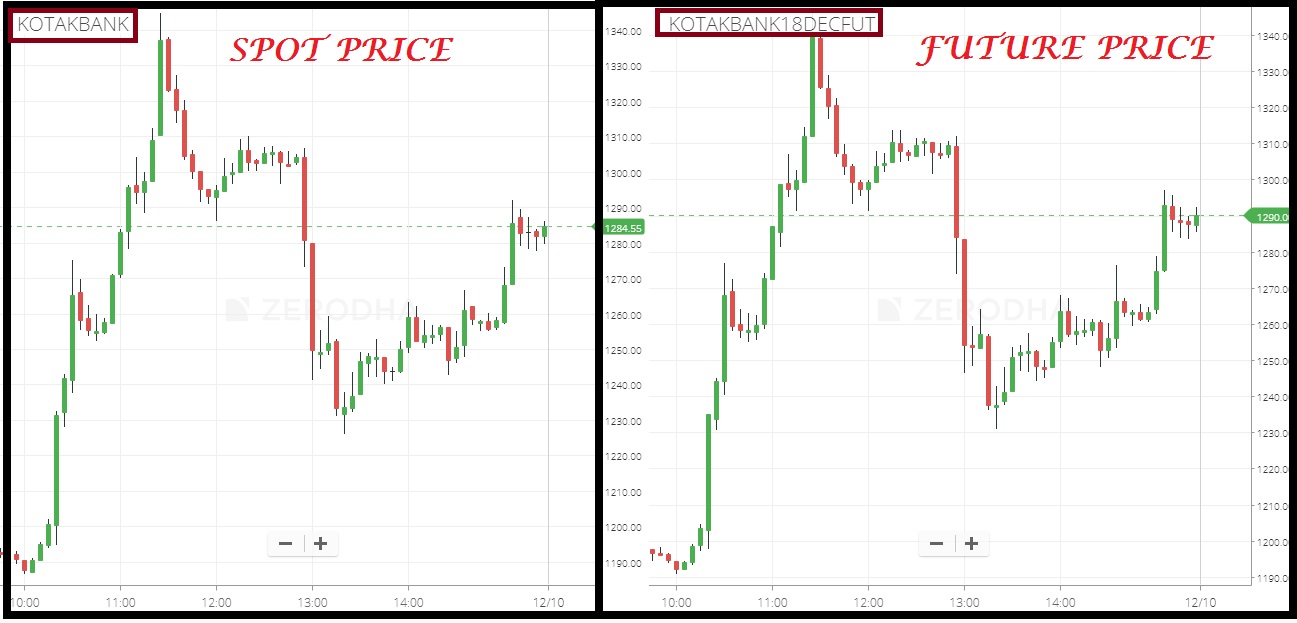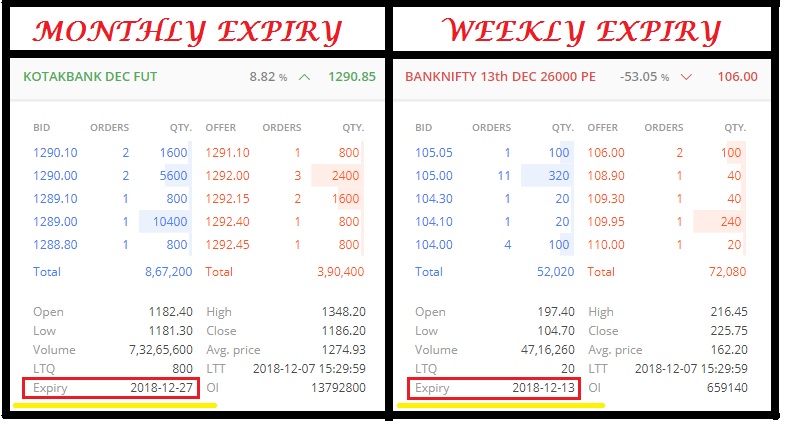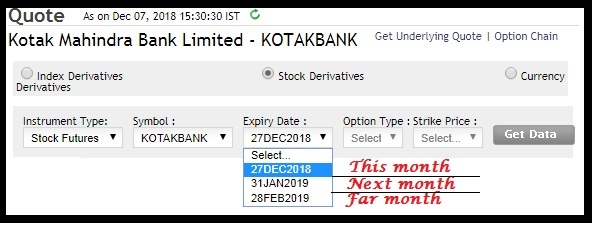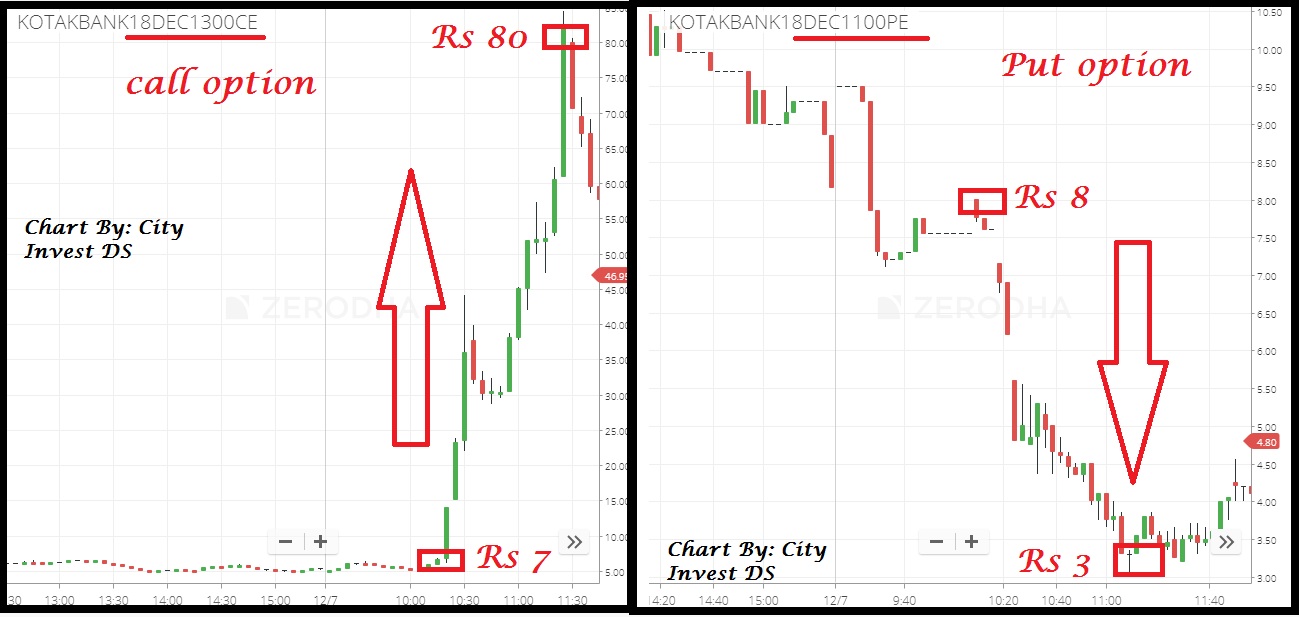Future Options is just another Asset which we can trade in a stock exchange, If we have to gain some knowledge about future and options then we have to learn about these three contents :
Future & Options are derivative Instrument, Here derivative means those assets which derive it’s value from underlying asset ( Spot value).
- SPOT
- FUTURE
- OPTIONS
Spot means the price of equity share or Index ( or we can say underlying asset price) like if I am talking about buying Ashok Leyland put that means something going to happen with Ashok Leyland share price, and when I say Buy Bank nifty 26000 put that means there will be some movement in Bank Nifty Index.
Future means a derivative contract which follows the trend of Spot price, but here we have to buy some large Qty as compare to Equity shares. Future is one of the risky assets. You can buy-sell, Sell-buy any future there is no restriction of it. Like in Equity share we can short sell for Intraday basis only, but with future, we can short sell any number of days.
Options mean a derivative contract which follows the trend of Spot price, options are of two Types call option and put option. Options are not as risky as compared to future WHy? check all detail below.
Future Contract
-
Basic Introduction :
Future Contract follows the trend of Spot like if Kotak Bank share price rally 10% then the Future contract of Kotak Bank have to rally 10% that’s why we say them the derivative product because future gets its value from an underlying asset which is the equity share price of Kotak ( Spot price). Like in the chart below there is a good explanation. You can see Future Price having the same fluctuations as Spot price.
-
Why there is the difference in Price of Spot and Future?
The difference between the spot price and the futures price is due to the cost of carrying. Cost of carrying is the cost attached with holding the physical stock for a specified period of time such as insurance, interest, etc.
If futures price is higher than the spot price, this is known as Contango and, a situation in which the futures price is lower than the spot price is said to be in Backwardation. We often use terms like PREMIUM for contange and DISCOUNT for backwardation. sometimes due to corporate action like Dividend announcements price of future can go into Discount, but all price adjustment is there before starting of new month contract and there will no loss to any trader, Because whenever a new month contract starts it start with some calculation of formula, and after getting information from the pricing formula traders start placing their order.
The futures pricing formula simply states –
Futures Price = Spot price *(1+ rf – d)
Where,
rf = Risk-free rate
d – Dividend
Note, ‘rf’ is the risk free rate that you can earn for the entire year (365 days); considering the expiry is at 1, 2, and 3 months one may want to scale it proportionately for time periods other than the exact 365 days. Therefore a more generic formula would be –
Futures Price = Spot price * [1+ rf*(x/365) – d]
Where,
x = number of days to expiry.
One can take the RBI’s 91 day Treasury bill as a proxy for the short term risk free rate.
-
Expiry :
In all Derivative products, there is expiry every last Thursday of a month, that means if you are having any position of future and options you have to square-off it before 3:30 pm on expiry day. ( Except Weekly Bank Expiry which expires on every week Thursday). So we can differentiate in two expiries Monthly and Weekly expiry.  Generally, in Market, you will get 3-month expiry, like this month ( December Expiry), next month( January Expiry) and far month (Feb Expiry), and whenever an expiry ends Exchange will introduce new month automatically.
Generally, in Market, you will get 3-month expiry, like this month ( December Expiry), next month( January Expiry) and far month (Feb Expiry), and whenever an expiry ends Exchange will introduce new month automatically. 
At the time of expiry Spot price and the Future price will be equal, If there is a gap at the time of expiry then it means some corporate action may be there in market, generally dividend get adjusted in future price, If you are holding future then you will not get dividend but that dividend amount will be adjusted in the market.
-
Margin :
Margin plays a big role in a future contract Because here you have to buy Heavy Qty. Like in Kotak Bank if we want to buy one future contract then we have to buy a minimum 800 qty, that means you can’t any anything below this, and if you want to buy more then only in multiple of 800. Lot Size
Value of 1 lot = 800(qty)*1290(Price of Future)= 1032000 ( 10.32 Lakh)
we only have to pay Margin money, and Margin money is divided into two parts
- Initial Margin/SPAN: Initial margin for F&O segment is calculated on a portfolio (a collection of futures and options positions) based approach. The margin calculation is carried out using a software called – SPAN® (Standard Portfolio Analysis of Risk). It is a product developed by the Chicago Mercantile Exchange (CME) and is extensively used by leading stock exchanges of the world. SPAN system, through its algorithms, sets the margin of each position in a portfolio of derivatives and physical instruments to its calculated worst possible one-day move. Generally SPAN Margin in near 11-13% of notional Value of position. The SPAN margin for a particular security keeps changing from time to time-based on the volatility of the underlying
- Exposure Margin: Exposure margins in respect of index futures is 3% of the notional value. For futures on individual securities Exposure margin is of 5% of the notional value of the position. Exposure margin usually remains the same since its basic function is to work as an additional safety net for the broker.
If we Calculate SPAN margin of Kotak future contract i.e. 10.32Lakh*11%= Rs 113500.
and Exposure Margin of Kotak future contract i.e. 10.32Lakh*5%= Rs 51600
Total Margin = SPAN+Exposure = 113500+51600= Rs 165100. That means we have to pay Margin amount of Rs 165100** to Buy/sell one future contract. Margin money is same for buying and selling. You only have to pay margin once you are making a new position and when you close that position then you will get back all margin in your trading account.
If we have this amount of money in our trading account only then our broker will allow us to Buy/sell one future contract. If you want to buy/sell a futures contract for intraday basis then broker can allow you with half of the original margin amount. Its all depend on broker and relationship with your Relationship Manager, if you have good bonding then he can allow you to buy a future contract with less margin.
**= Margin Amount always change as per change in volatility in the market, Higher the volatility, higher the amount of margin.
Beside this 1.65 Lakh Margin Money, you also have to maintain near about 25% more of it, Because there will be volatility in the market and to protect our position we have to deposit more money, It is advised to maintain somewhere between 20-25% more as of Margin Amount. If you fail to maintain additional 20-25% Cash in your trading account, then broker might close your position in case of high volatility in the market.
20-25% more we require because of MTM (Mark to market) that means whatever loss or profit you are having on one-day basis broker will debit/credit from/to your account. Like if you bought a Kotak 1 future contract (800Qty) at Rs 1290 and the market closes at Rs 1300 then the broker will deposit (10*800qty)=8000 in your account as a Positive MTM. If Kotak Future closes at Rs 1270 then the broker will deduct (10*800qty)=8000 from your account as a negative MTM and this will continue till you close your position.
Options Contract
-
Basic:
Options are of two types Call and Put options, they follow the trend of Spot price, but there are many things to focus on while buying/selling options. Options are generally in Retail Trader radar because their value is small and they can give huge return if you are sitting on the right track, if not then your options value will decrease heavily like 40-60% in a couple of minutes. In theories, you will get many confusing definitions of options, but here we only want to know what call/put option means and how they work.
Call option= If your view about market/Individual share is bullish then you have to buy call option. In Indian market Call option is denoted as CE
Put Option=If your view about market/Individual share is bearish then you have to buy put option. In Indian Market put option is denoted as PE
Now, whenever market changes the trend like bullish, bearish then according to it these options behaves, and fluctuations will be there in both options Like if call option goes up, put option has to come down and vice-versa. Will explain this thing by giving you an example of Kotak Bank. Yesterday Kotak Bank rally 12% in 1.5 hours and call option rally from Rs 7 to Rs 80 ( Profit of 1000%) and Put option fell down from Rs 8 to Rs 3 ( Loss of 62%). In options, lot size is same as of future contract, like If Kotak future contract having 800 qty then call/put option have the same qty. Lot Size So keep this in your mind that whenever a stock/Index rally call has to go up and put option have to come down, that’s how Option Market behaves. Here you can create any position like Buy call/Sell call/Buy put/sell put as per your understanding about market and you have to close your position at the time of expiry or before as per your target and stop loss.
So keep this in your mind that whenever a stock/Index rally call has to go up and put option have to come down, that’s how Option Market behaves. Here you can create any position like Buy call/Sell call/Buy put/sell put as per your understanding about market and you have to close your position at the time of expiry or before as per your target and stop loss.
And whenever a stock/Index fall down then Put option will rally and call options have to come down.
-
Premium/Margin :
If you are Buying an option then you have to pay a premium amount i.e. Price of the option, In option market premium = price of the option. ( Here I am talking about creating a new buy position in option) like your option price is Rs 7 and lot size is 800qty per lot, then you have to pay 7*800= 5600, If you have this amount in your account then only your broker will allow you to buy this option. Here the risk is only of the premium you are paying that means if the stock price moves in your favor then you will get good profit in your options, if not then this Rs 5600 can go down to 1500-2000 or can go to 0 also in case of expiry.
If you are selling an option then you have to pay a Margin amount i.e. Margin of a future contract, ( Here I am talking about creating a new Sell position in option). We have to pay Margin because while selling an option there is high risk because it can go up to any price, like if I sold option at Rs 20 and I thought to buy it back at Rs 10 to get small profit, but what if it rally to Rs 50-80, then who is responsible to this loss, that’s why we have to maintain Margin while selling an option. Selling option is risky as compared to Buying option, Because..
Buying an option have limited risk and unlimited profit and selling an option have unlimited risk and limited profit.
-
Factors affecting option price :
There are 4 Important Factors affecting the price of an option,
- Underlying price: The most influential factor on an option premium is the current market price of the underlying asset. In general, as the price of the underlying increases, call prices increase and put prices decrease. Conversely, as the price of the underlying decreases, call prices decrease and put prices increase.

- Strike Price: The strike price determines if the option has any intrinsic value. Remember, intrinsic value is the difference between the strike price of the option and the current price of the underlying asset. The premium typically increases as the option becomes further in-the-money (where the strike price becomes more favorable in relation to the current underlying price). The premium generally decreases as the option becomes more out-of-the-money (when the strike price is less favorable in relation to the underlying security). “Premiums increase as options become further in-the-money.”
- Time Until Expiration: The longer an option has until expiration, the greater the chance it will end up in-the-money (profitable). As expiration approaches, the option’s time value decreases. As a general rule, an option loses one-third of its time value during the first half of its life, and two-thirds of its value during the second half. The underlying asset’s volatility is a factor in time value: If the underlying is highly volatile, you can reasonably expect a greater degree of price movement before expiration. The opposite holds true where the underlying exhibits low volatility: The time value will be lower if the underlying price is not expected to move much. “The longer the time until expiration, the higher the option price” “The shorter the time until expiration, the lower the option price”
- Expected Volatility: Volatility is the degree to which price moves, whether it goes up or down. It is a measure of the speed and magnitude of the underlying’s price changes. Historical volatility refers to the actual price changes that have been observed over a specified time period. Options traders can evaluate historical volatility to determine possible volatility in the future. Implied volatility, on the other hand, is a forecast of future volatility and acts as an indicator of the current market sentiment. While implied volatility can be difficult to quantify, option premiums are generally higher if the underlying exhibits higher volatility because it will have higher expected price fluctuations. “The greater the expected volatility, the higher the option value”.
This is a simple explanation of Future & options, Next time I will give some more deep information about options, till then keep learning about derivatives.
If you like this article then keep forwarding to your friends, it took 4 hours to make this, the least you can do is to forward it to your 4 friends who don’t know about Derivatives, so that they are aware of all this thing and can learn more from my next articles.




12 Comments
Nice Article. Thanks 🙂
Thanks 🙂
Very good info
Plz tranlate in Hindi or Marathi for easy understanding of a lot of people.
It is difficult for me to translate it to Marathi & Hindi, but will check with some friends, if they can do then will post that.
Looking forward to your next article on options. Nice .
Thanks 🙂 Soon new article will be there.
nice one man, looking forward to your next article about derivatives
Thanks Sir, Will update about it.
Nice. Easy to understand. Keep posting.
Thanks 🙂
Very nicely explained in minimal words, examples given made it crystal clear.
Looking forward to read more from you, Divish.
Thanks 🙂 More good information will be there soon. Thanks for reading.